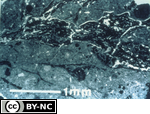Download Image
5.26 MB

ID # 166
Organic laminae and lenticular pellets (termite mound)From the Soil Micromorphology Slide Collection
STEM Standard addressed: ESS2E - Biogeology
Appropriate Grade Level(s)
- College-level
- Classroom Lectures
- Laboratory Activities
- Soil Microbiology
Description of slide: The fabric consists of distinct organic laminae and lenticular pellets. In the slide there are isotropic organic laminae (dark central part of the micrograph). The laminae are quite visible in the wall section and are distinct on the gallery wall and within gallery fills. This indicates addition of organic matter to mound construction. Typical lenticular pellets are visible in the upper and lower part of the micrograph. The degree of welding and pressure direction determine the size of units. Different sizes and shapes may occur in the same part of the mound. Thin organic laminae are also present between lenticular pellets.
Data for the horizon
Horizon sampled: The wall of a Macrotermes subhyalinus mound. The fabric is made of soil material and may be fecal pellets.
Depth sampled: 120-140 cm
Physical and chemical data available: Particle size distribution: 1 1 % sand, 35% silt, and 54% clay; pH 6.8; organic carbon 0.92%; volume of pores larger than 12 um is about 1 1 .7%. See reference for more information.
Data for thin section
Preparation of sample: Air dry
Impregnating medium: Vestopal-1 50
Thickness of section: 25 µm
Soil Classification
F.A.O.: Humic Cambisol
Elevation: 1402 m
Parent material: Tertiary volcanics
Soil climatic data and/or soil water balance: Mean annual temperature 230C; mean annual precipitation 600 mm
Vegetation: Acacia shrubs
Data for the horizon
Horizon sampled: The wall of a Macrotermes subhyalinus mound. The fabric is made of soil material and may be fecal pellets.
Depth sampled: 120-140 cm
Physical and chemical data available: Particle size distribution: 1 1 % sand, 35% silt, and 54% clay; pH 6.8; organic carbon 0.92%; volume of pores larger than 12 um is about 1 1 .7%. See reference for more information.
Data for thin section
Preparation of sample: Air dry
Impregnating medium: Vestopal-1 50
Thickness of section: 25 µm
Soil Classification
F.A.O.: Humic Cambisol
Elevation: 1402 m
Parent material: Tertiary volcanics
Soil climatic data and/or soil water balance: Mean annual temperature 230C; mean annual precipitation 600 mm
Vegetation: Acacia shrubs
Method
Data for 35-mm slide
Frame length: See bar scale on slide
Light mode: Plane polarized
Frame length: See bar scale on slide
Light mode: Plane polarized
References
Mermut, A. R., M. A. Arshad, and R. J. St. Arnaud. 1 984. Micropedological study of termite mounds of three species of macrotermes in Kenya. Soil Sci. Soc. Am. J. 48: 613-620.
Source - A. R. Mermut
Slide BF22. Soil Science Society of America, 1993. A Reference Slide Collection for Soil Micromorphology. SSA, Madison, WI.
Source - A. R. Mermut
Slide BF22. Soil Science Society of America, 1993. A Reference Slide Collection for Soil Micromorphology. SSA, Madison, WI.
Peer Review: Yes
Credit this item to: SSSAMedia Date: 1993-01-01
Provided By: (SSSA) Soil Science Society of America
Author(s)/Creator(s)
-
* Soil Science Society of America
SSSA
Submitted By: (SSSA) Soil Science Society of America
Keywords
- Biological Features
- The wall of a Macrotermes subhyalinus mound. The fabric is made of soil material and may be fecal pellets.
- micromorphology
- Laminae pellets and lenticular pellets (termite mound)
Comments
Please login to submit a comment.
Log In to your account
Already a member, certified, or existing customer?*
* Cookies must be accepted to log in.
Not sure if you have an account?
Check Your Email
Join Us!
Connect with members and access the information you need.
Learn more.
Ready to Join?
If you have an account, login on the left. Not sure if you have an account or need to create one? Check your email with the link above. We look forward to welcoming you.